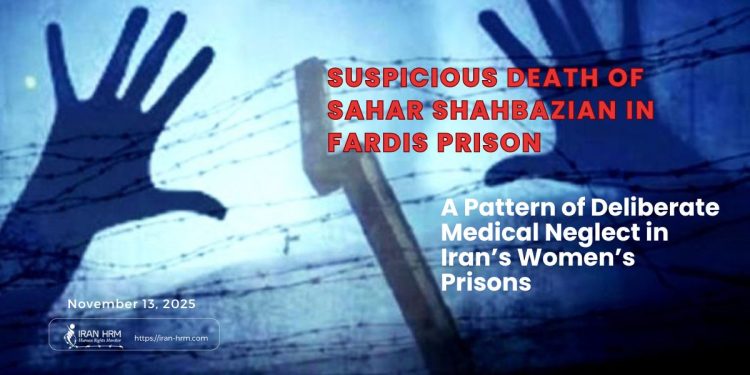The death of Sahar Shahbazian, a 26-year-old prisoner, on 12 November 2025 in Fardis Prison (Kachui) in Karaj has once again highlighted the life-threatening conditions faced by women detainees in Iran. According to reliable sources, Shahbazian suffered a cardiac arrest and died due to delayed medical intervention. Prison officials, however, claimed she died of “overdose,” a statement that contradicts eyewitness reports and the account of those close to her. Shahbazian, detained on a homicide charge, had reportedly been proven innocent during investigation but remained in custody. The failure to transfer her to hospital in time cost her life — another preventable death behind the walls of Iran’s prisons.
Recurring Deaths in Fardis Prison (Kachui)
Just two months earlier, Maryam Shahraki, a 40-year-old woman and mother of two, died in the same prison after suffering severe chest pain. She had been imprisoned solely for her inability to pay a 300-million-toman debt. Prison physician Dr. Nasir misdiagnosed her cardiac symptoms as stomach pain and sent her back to her ward with only a few pills. Hours later, she collapsed and died of cardiac arrest before reaching hospital. Witnesses confirmed that timely hospital transfer could have saved her life. Her death underscored the deep medical crisis inside Fardis Prison (Kachui), where inmates must wait hours or even days for hospital referrals, often denied altogether by the prison’s medical staff.
From Qarchak to Fardis: A Systemic Pattern
The same pattern has claimed lives beyond Fardis Prison. Somayeh Rashidi, a 42-year-old political prisoner in Qarchak Prison, suffered from epilepsy and repeatedly requested medical care. Her appeals were ignored. Deprived of medication, she experienced repeated seizures, fell into a ten-day coma, and died at Mofatteh Hospital in Varamin. Human rights observers describe these deaths as part of a broader policy of “silent execution” — a method of killing prisoners through systematic deprivation of medical care rather than overt violence. Women prisoners, particularly political detainees, remain most vulnerable to this lethal neglect.
Legal and Human Rights Violations
The repeated deaths of women in custody reflect systematic violations of Iran’s obligations under international law:
– Article 6 of the ICCPR (Right to Life): States must protect the lives of those under detention.
– Article 10 of the ICCPR (Humane Treatment): Denial of medical care violates the inherent dignity of prisoners.
– UN Standard Minimum Rules for the Treatment of Prisoners (Nelson Mandela Rules): Prisoners must have equal access to healthcare as free citizens.
By disregarding these obligations, the ruling regime in Iran has institutionalized a policy of medical neglect amounting to inhumane treatment and arbitrary deprivation of life.
Conclusion
The deaths of Sahar Shahbazian, Maryam Shahraki, and Somayeh Rashidi are not isolated incidents but part of a systematic pattern of deliberate neglect in Iran’s prisons. Fardis (Kachui) and Qarchak have become symbols of state cruelty, where denial of healthcare serves as an instrument of punishment. Until independent oversight and accountability mechanisms are established, Iranian prisons will remain silent death chambers — and women like Sahar, Maryam, and Somayeh will continue to die unheard.







